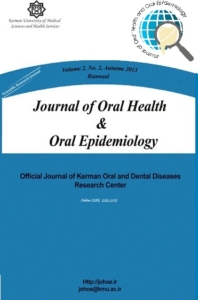Dental health by age, gender, and residence place in 6- to 12-year-old children living in Shahroud, Iran
Authors
Mohammad Hassan Emamian 1, Arash Sang 2 , Mohammad Shamsaei 3 , Hassan Hashemi 4 ,Akbar Fotouhi 5
Affiliations
1 Associate Professor, Ophthalmic Epidemiology Research Center, Shahroud University of Medical Sciences, Shahroud, Iran
2 Researcher, Student Research Committee, School of Medicine, Shahroud University of Medical Sciences, Shahroud, Iran
3 Researcher, Vice-chancellery of Health, Shahroud University of Medical Sciences, Shahroud, Iran
4 Professor, Noor Research Center for Ophthalmic Epidemiology, Noor Eye Hospital, Tehran, Iran
5 Professor, Department of Epidemiology and Biostatistics, School of Public Health, Tehran University of Medical Sciences, Tehran, Iran
Abstract
Background: Vision-related quality of life is related to severity of visual impairments and show the impact of eye diseases on daily activities. This study aims to assess visual functions and disability and its association with age, gender, education, marital status, and economic status in adults aged 45-69 years.
Methods: Data in this population-based study were from the second phase of the Shahroud eye cohort study and collected by using a Short-Form Visual Functioning Scale. The scores of visual function and disability were calculated based on Rasch-transformed scores of the National Eye Institute visual functioning questionnaire, where a more negative score indicates a better situation. Multiple linear regression was used to investigate the factors associated with visual functions.
Results: Among 4737 participants the visual function data for 4715 people were analyzed. The visual function of 75.3, 17.1 and 7.5% of participants were “ideal and good”, “moderate”, and “bad and very bad”, respectively, while 0.06% were unable for vision. The running mean of the visual function was calculated to be – 3.95 ± 0.02. The visual performance was worse in females than the males (β = 0.14, p = 0.005). Visual function improved with increasing levels of education (β = – 1.06, p < 0.001). It was worse in low-economic (β = 0.016, p = 0.005) and moderate-economic (β = 0.28, p < 0.001) participants than high-economic ones.
Conclusion: The visual function of Iranian adults aged 45-69 years was moderate. The male gender, higher education and the higher economic status had a better visual function.
Keywords: NEI-VFQ; Population-based study; Short-form visual functioning scale; Visual function.

